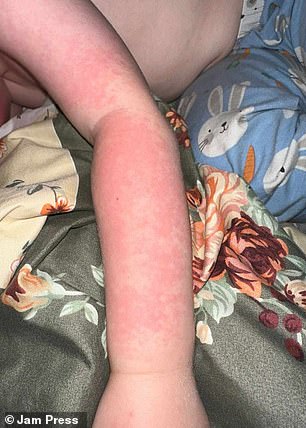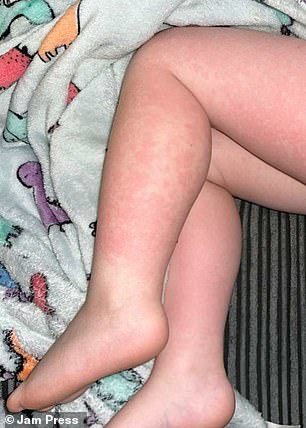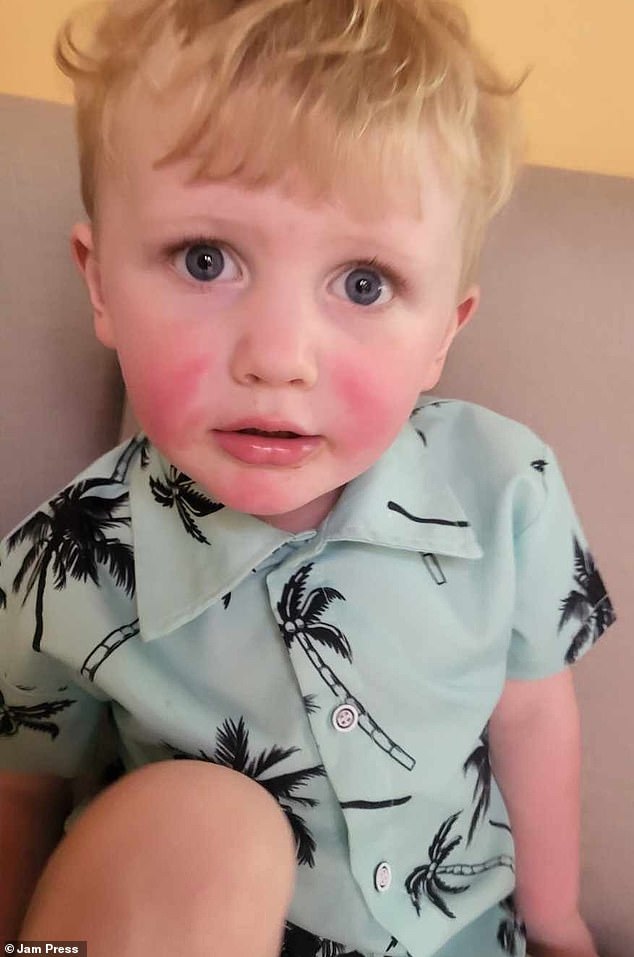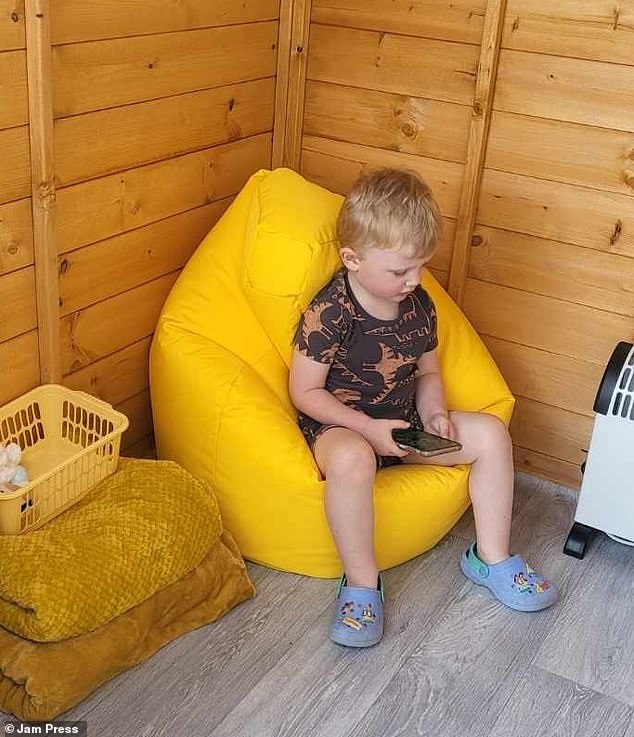Three-year-old with extremely rare sun allergy must stay indoors all summer to avoid painful blisters
A three-year-old boy is ‘forced’ to stay indoors all summer due to an extremely rare sun allergy.
Cole Pugsley suffers from polymorphic light eruption (PMLE), which causes his skin to develop painful rashes and blisters, even after just a few minutes in the sun.
But the condition, which affects an estimated 10 to 15 percent of the UK population, has no cure.
This means that the child cannot go on holiday abroad or sit in sunlight shining through the window without having a painful reaction.
In the summer, mum Hanna-May Pugsley, 32, and her partner Ryan, 30, have to take Cole and his brother Dray, 8, out at 8am and make sure they’re home by 11am.
Three-year-old Cole Pugsley can’t go on holiday abroad or even sit in the sunlight from a window without suffering a painful reaction

In the summer, mum Hanna-May Pugsley, 32, and her partner Ryan, 30, have to take him and his brother Dray, eight, out at 8am and make sure they’re home by 11am.


Cole Pugsley has polymorphic light eruption (PMLE), which causes his skin to break out in painful rashes and blisters — even after just a few minutes in the sun. It typically affects the areas of skin most exposed to sunlight, such as the head, neck, chest and arms, according to the NHS
“Every time he goes outside, even for five minutes, he gets pain from every part of his body that is exposed,” said Mrs Pugsley, a night watchman from Arbertillery, Wales.
‘He’s in a lot of pain and discomfort and is getting a nasty rash. It could cause scarring.
“I’m afraid of hot weather. My mom calls to tell me if it’s going to be hot and instead of being excited I say, ‘Oh God, no.’ It’s a nightmare.
‘Even if he’s in the car or on the couch and the sun is shining through the window, I have to cover him completely.
‘He has to wear long pants and sleeves, so he struggles a lot in the heat.
“There is no cure. He takes antihistamines every day.
‘I have to arrange outings when it rains.
‘He can’t enjoy anything. He won’t be able to experience the summer.
‘It has changed the way we think about everything. We wanted to go to Spain in September, but that has to change.
‘Going on holiday abroad is not possible at all until he is older and can make his own decisions.
“I’m not going to put him in an uncomfortable position.
‘Instead of going on holiday to a sunny place, we will have to go to a colder place in the colder season.
‘Luckily we live in Wales. If we lived somewhere warm, he would really suffer.’
The allergy is triggered by exposure to sunlight or artificial ultraviolet (UV) light. It is thought that this changes a substance in the skin that the immune system reacts to, resulting in inflammation of the skin.
It causes an itchy, burning rash that can appear within hours of exposure and last up to two weeks.
Some people develop blisters that turn into larger, dry patches that resemble eczema, while others develop red, raised patches.
According to the NHS, the areas of skin most exposed to sunlight, such as the head, neck, chest and arms, are most commonly affected.
Cole was diagnosed with PMLE in June 2024 after developing hives after just ten minutes of playing in the yard.
Mrs Pugsley said: ‘Every time he went out into the garden or the park he would develop an ugly red rash within ten minutes and sometimes blisters too.
He became very hot and grim.
‘I already suspected that it had something to do with the sun.
“His father didn’t believe it because he didn’t know it existed. But as his mother, I knew.”
‘I went to the doctor with him and he said it was PMLE.’

The allergy is caused by exposure to sunlight or artificial ultraviolet (UV) light. It is thought that this changes a substance in the skin that the immune system reacts to, resulting in inflammation of the skin.

The family has decided to swap their trip to the sunny Spanish coast for a trip to Scotland.

The family organizes trips to the aquarium and avoids outdoor activities. They even organize outings when it rains.

Cole’s grandfather built a garden shed in the family’s yard so he can play outside with his brother
Now the family has decided to swap their trip to the sunny Spanish coast for a trip to Scotland.
Cole’s grandfather built a garden shed in the family’s yard so he could play outside with his brother.
Mrs Pugsley added: ‘It’s tricky trying to put sunscreen on a three-year-old and keep a hat on.
‘We have to bribe him with candy to make him take his antihistamines.
‘We should take him to indoor adventure parks, but I feel sorry for Dray when the weather is nice.
‘We have to do indoor activities, like going to the aquarium.
‘They have new electric scooters and we can’t ride them.
‘He wants to play outside. My father built him a summer house and they had a water fight, but he had to stay inside.
‘We used to go to the beach with Dray every few weeks, but Cole never really went.’
